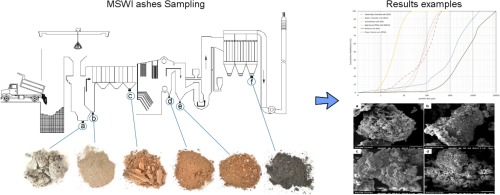当前位置:
X-MOL 学术
›
J. Environ. Manag.
›
论文详情
Our official English website, www.x-mol.net, welcomes your
feedback! (Note: you will need to create a separate account there.)
Study on physiochemical properties and leaching behavior of residual ash fractions from a municipal solid waste incinerator (MSWI) plant.
Journal of Environmental Management ( IF 8.0 ) Pub Date : 2020-01-11 , DOI: 10.1016/j.jenvman.2019.110042 Morteza Nikravan 1 , Ali Akbar Ramezanianpour 1 , Reza Maknoon 1
Journal of Environmental Management ( IF 8.0 ) Pub Date : 2020-01-11 , DOI: 10.1016/j.jenvman.2019.110042 Morteza Nikravan 1 , Ali Akbar Ramezanianpour 1 , Reza Maknoon 1
Affiliation

|
Generally, Fly ashes (FAs) in Municipal Solid Waste Incinerator (MSWI) are classified as hazardous waste and commonly managed in a mixed way even though distinct FA in incineration flows have different characteristics. Thus, it can cause improper management of fly ashes and an increase in cost as well as the volume of residual ashes sent to the hazardous landfill. In this study, Bottom ash (BA), Secondary furnace ash (SFA), Superheater ash (SHA), Boiler chamber ash (BCA), Economizer ash (EA), and Baghouse Filter Ash (BHFA) have been sampled separately from different locations at an MSWI plant. An integrated approach involving physical, chemical, mineralogy, and leaching behavior was used to characterize the residual ashes. Results point out that the average diameter of ash particles varies from 4.87 μm for BHFA to 6825 μm for BA, with three distinct zones. The Blaine fineness value increases when the median size of ash particles decreases. All values of Loss on Ignition (LOI) at 550 °C are less than 3%, indicating a suitable burning. The main mineralogical crystalline phases in ashes were KCl, NaCl, Mg.6Al1.2Si1.8O6, CaCO3, CaSO4, CaSO3, and SiO2. Among the considered heavy metals, leaching tests identified high levels of hazardous waste for Pb, Cd, Cu, and Zn in BHFA as well as for Pb and Zn in SHA. BA, SFA, BCA, and EA are categorized as non-hazardous according to the TCLP (USEPA-1311). In terms of EN 12457-2 test, BA and SFA are inert waste; but SHA, BCA, and EA are classified as hazardous waste due to a significant level of Cl. The results show that the characteristics of ash in the separate location of the MSWI process is essential to have an economical and proper solution for ash management.
中文翻译:

研究城市生活垃圾焚化炉(MSWI)残留灰分的理化特性和浸出行为。
通常,即使焚烧流中不同的FA具有不同的特性,市政固体废物焚化炉(MSWI)中的粉煤灰(FA)也被归类为危险废物,并且通常以混合方式进行管理。因此,这可能导致粉煤灰的管理不当,并增加成本以及送往危险垃圾填埋场的残留灰烬的数量。在这项研究中,底灰(BA),二次炉灰(SFA),过热器灰(SHA),锅炉室灰(BCA),省煤器灰(EA)和布袋除尘器灰(BHFA)已从不同位置分别采样在MSWI工厂。使用涉及物理,化学,矿物学和浸出行为的综合方法来表征残留灰烬。结果指出,灰烬颗粒的平均直径从BHFA的4.87μm到BA的6825μm不等,具有三个不同的区域。当灰分颗粒的中值尺寸减小时,布莱恩细度值增加。550°C下的所有燃烧失重(LOI)值均小于3%,表明燃烧适当。灰烬中的主要矿物晶体相为KCl,NaCl,Mg.6Al1.2Si1.8O6,CaCO3,CaSO4,CaSO3和SiO2。在考虑的重金属中,浸出测试发现BHFA中的Pb,Cd,Cu和Zn以及SHA中的Pb和Zn的有害废物含量高。根据TCLP(USEPA-1311),BA,SFA,BCA和EA被归类为非危险品。根据EN 12457-2测试,BA和SFA是惰性废物;但是SHA,BCA和EA由于含有大量的Cl,因此被归类为危险废物。
更新日期:2020-01-13
中文翻译:

研究城市生活垃圾焚化炉(MSWI)残留灰分的理化特性和浸出行为。
通常,即使焚烧流中不同的FA具有不同的特性,市政固体废物焚化炉(MSWI)中的粉煤灰(FA)也被归类为危险废物,并且通常以混合方式进行管理。因此,这可能导致粉煤灰的管理不当,并增加成本以及送往危险垃圾填埋场的残留灰烬的数量。在这项研究中,底灰(BA),二次炉灰(SFA),过热器灰(SHA),锅炉室灰(BCA),省煤器灰(EA)和布袋除尘器灰(BHFA)已从不同位置分别采样在MSWI工厂。使用涉及物理,化学,矿物学和浸出行为的综合方法来表征残留灰烬。结果指出,灰烬颗粒的平均直径从BHFA的4.87μm到BA的6825μm不等,具有三个不同的区域。当灰分颗粒的中值尺寸减小时,布莱恩细度值增加。550°C下的所有燃烧失重(LOI)值均小于3%,表明燃烧适当。灰烬中的主要矿物晶体相为KCl,NaCl,Mg.6Al1.2Si1.8O6,CaCO3,CaSO4,CaSO3和SiO2。在考虑的重金属中,浸出测试发现BHFA中的Pb,Cd,Cu和Zn以及SHA中的Pb和Zn的有害废物含量高。根据TCLP(USEPA-1311),BA,SFA,BCA和EA被归类为非危险品。根据EN 12457-2测试,BA和SFA是惰性废物;但是SHA,BCA和EA由于含有大量的Cl,因此被归类为危险废物。





















































 京公网安备 11010802027423号
京公网安备 11010802027423号